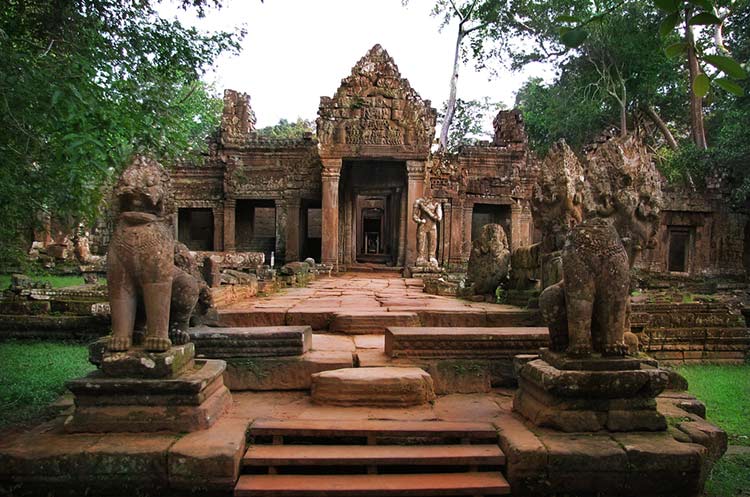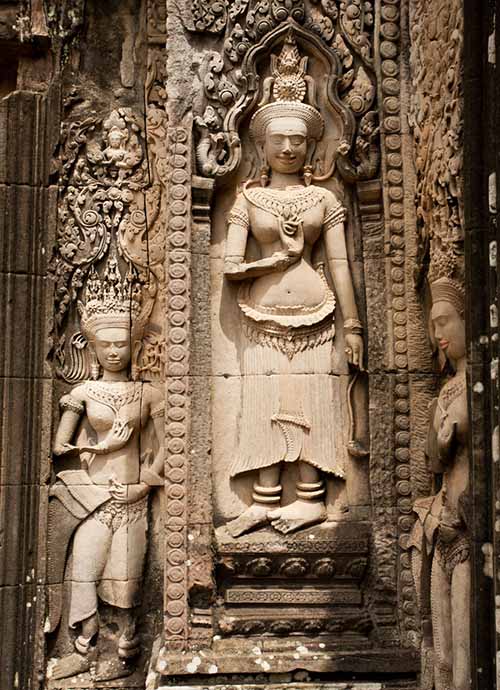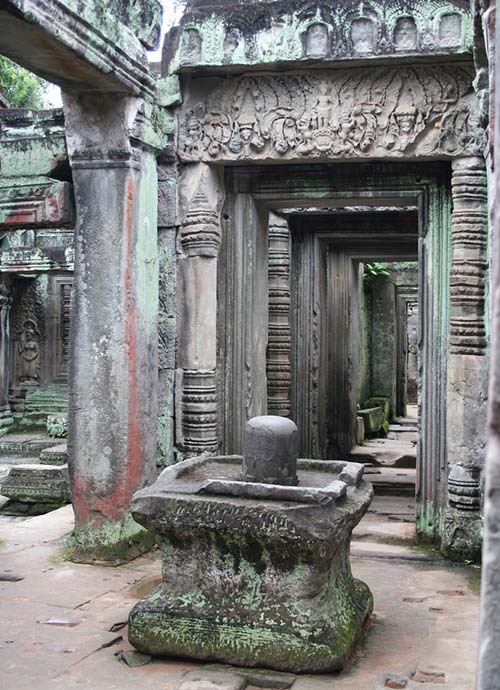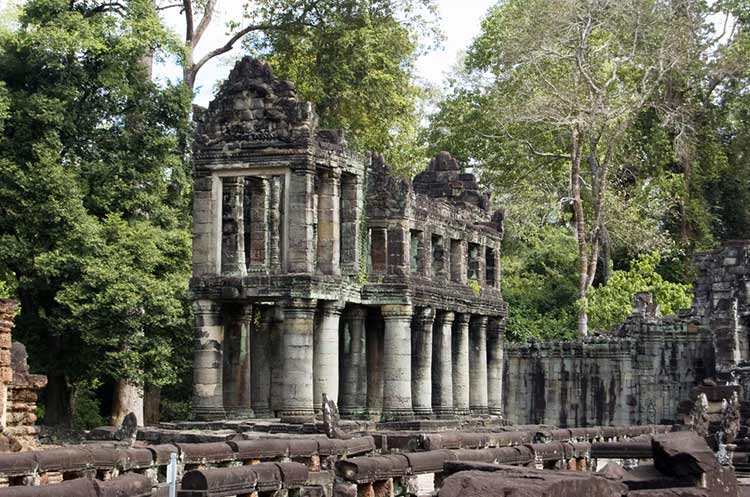
Preah Khan
Temple city with nearly 100,000 servants
The Preah Khan temple located just outside the capital city Angkor Thom was built in 1191; its name translates to “the Sacred Sword”.
The temple was built by Jayavarman VII, a Buddhist King who liberated Angkor by driving out the occupying forces of the Cham. The King who earlier dedicated the Ta Prohm temple to his mother, dedicated the Preah Khan to his father. The statue of Lokeshvara was carved to resemble the King’s father.
Large temple city
The Preah Khan was a temple city occupying a large area surrounded by a moat. The outermost enclosure was built up with wooden houses and huts where common people lived. The wooden structures have long gone.
A hospital and a “house with fire”
On the grounds were also a hospital and a “house with fire”. The small inner sanctuaries are cramped with a great number of temple structures, including a well preserved Hall of Dancers.
Built as a Buddhist temple
As King Jayavarman VII was a devout Buddhist, the Preah Khan was built as a Buddhist temple. Most depictions of the Buddha have been destroyed or changed into praying Rishi figures during the Hindu reaction of King Jayavarman VIII in the 13th century.
Partially restored
Clearing works on the overgrown temple started in the late 1920’s. The temple has been partially restored using the anastylosis method, reconstructing the temple with the original architectural concepts in mind.

The Preah Khan stele
In 1939 Maurice Glaize, the French conservator of Angkor, discovered the Preah Khan stele under a pile of rubble. The stele measuring 2 meters by 0.60 meters is inscribed on all four sides.
Texts on the stele
It contains a wealth of information about the history of the temple. The stele contains an invocation to Lokeshvara and Prajnaparamita as well as to the three jewels of Buddhism, namely the Buddha, the Dhamma or Buddhist teachings and the Sangha, the Buddhist community.
The text praises Jayavarman VII, the King who built the temple and mentions that the King founded a city named Nagara Jayasri, which translates to “the City of the Sacred Sword”.
From the texts it is known that close to 100,000 people were dedicated to serve the temple, including rice farmers, monks and dancers. It also lists the wealth of the temple, including silver, gold and gems.
The stele mentions that in 1191 a statue of Lokeshvara, the Bodhisattva of compassion was consecrated, carved to resemble the father of Jayavarman VII.
Eastern approach to the temple
In front of the temple’s Eastern entrance are the ruins of a small landing area for boats with a couple of lions standing guard. The pier is situated on the Western bank of the Jayatataka baray, a huge water reservoir (now dry) immediately East of the temple. From this pier, the King could embark a boat to the Neak Pean temple, which is located in the center of the baray.
From the landing area a 100 meters long walkway with boundary stones leads to the causeway crossing the moat. The Buddha images carved into the boundary stones have been destroyed. The moat is crossed by a bridge lined with giants holding the body of the mythological Naga snake.

The 4th enclosure with the Dharmasala
The temple grounds are divided into four enclosures. The 4th enclosure contained within the moat is over 900 meters long and 750 meters wide. This space was occupied by long gone wooden houses of villagers and servants.
Five meter tall Garudas
The wall of the fourth enclosure contains five meter tall Garudas fighting Naga snakes. Dozens of the mythological half man, half bird creature are placed at regular intervals around the more than three kilometers long fourth enclosure.
The gopura gate of the Eastern main entrance consists of three towers, the central one being the largest, which contains an entrance gate large enough for elephants to pass. Along the walkway to the third enclosure is a well preserved Dharmasala or “house of fire”.
The 3rd enclosure with the Hall of Dancers
The third enclosure measures 220 meters long and 165 meters wide. At the gopura of the East entrance which consists of three towers is a very well preserved guardian lion statue. The carved depictions of the Buddha have been altered to praying Rishis. Just past the gopura is a well preserved Hall of Dancers with beautiful devatas carved above the entrance doors.
Two storey building
North of the Hall of Dancers is a two storey building with large circular columns. Although it is not known what the purpose of this structure was, some speculate it might have been a granary building.
Between the Hall of Dancers and the second enclosure is a courtyard with two very small library buildings.
The 2nd enclosure
The second enclosure was added at a later stage. As a result, the space between the first and second enclosure is very small. Six sanctuary buildings were built between the two enclosures on the East side of the temple.

Inner sanctuary
The first enclosure which contains the inner sanctuary, the most sacred part of the temple, is a square area measuring 55 meters on all sides. The surrounding wall contains Buddha images, that have escaped the destruction of the Hindu reaction of the 13th century.
Funeral chapels and tombs
The inner sanctuary consists of four parts, divided by a gallery with a cruciform floor plan. The small space is cramped with a large number of small chapels, among them funeral chapels and tombs. Most depictions of the Buddha have either been destroyed or altered into praying Rishi figures. The Western entrance to the inner sanctuary is guarded by a well preserved Dvarapala guardian. The sanctuary’s lintels and pediments contain several depictions of Vishnu, Krishna and the Buddha.
Just West of the central sanctuary is a linga on a pedestal, which was probably moved from its original location inside the sanctuary.
Statue of eight armed Lokeshvara
In the center of the central sanctuary, at the location where originally the Lokeshvara image would have been, is a circular stupa that was built centuries after completion of the Preah Khan temple. In the Eastern vestibule of the main tower is a large statue of an eight armed Lokeshvara.
Satellite temples
Between the second and third enclosure are three satellite temples. While the Southern sanctuary building is in a ruined state, the Northern building is in a much better condition. The pediments and lintels contain several well preserved carvings including Vishnu reclining on Ananta, Krishna lifting Mount Govardhana, depictions of Shiva, Brahma and Vishnu and several battle scenes.
The entrance of the Western satellite temple is guarded by two huge Dvarapalas armed with a sword. The structure contains a library building opening to the West, away from the inner sanctuary. The lintels and pediments contain several depictions including Krishna lifting Mount Govardhana to protect the people and their cattle from torrential rain, Krishna, Vishnu and battle scenes from the Ramayana epic, like the battle of Lanka.
Location
The temple is located about fourteen kilometers North of Siem Reap town, immediately West of the Jayatataka baray and right across from the Northern Dei Chhnang Gate of Angkor Thom.
How to get there
A fun way to get there is by tuk tuk.
Find out about prices, how to find a good tuk tuk driver and what to do before the trip.
Alternatively, get there by taxi, motorbike or rented bicycle.